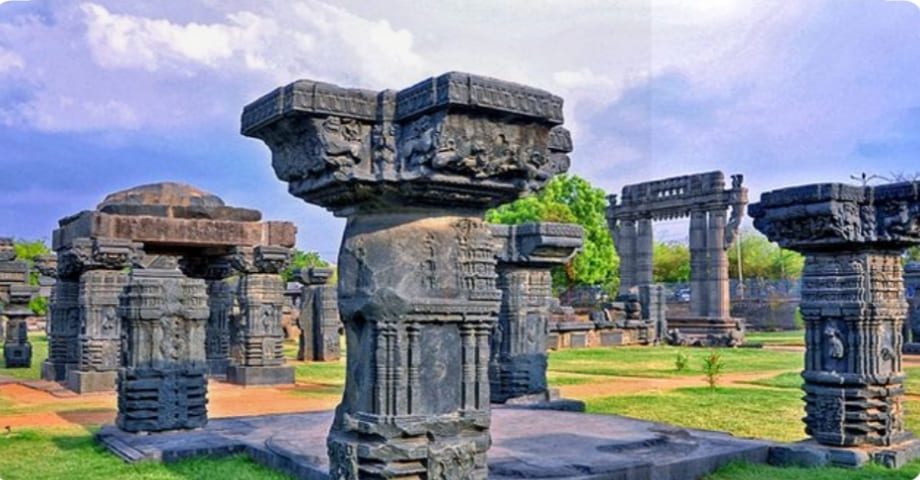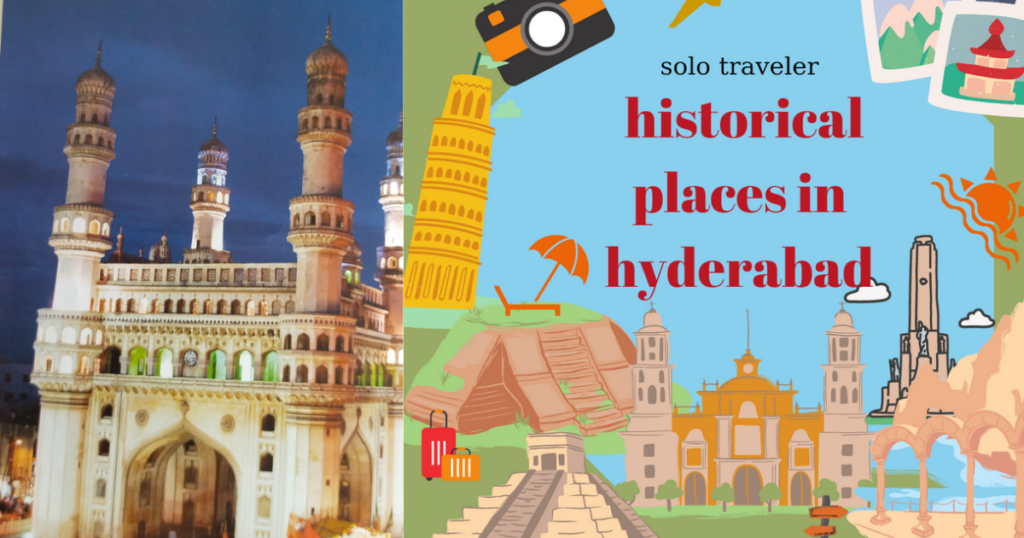India’s rich cultural heritage is a tapestry woven with threads of ancient traditions, diverse art forms, and profound spirituality. Spanning millennia, it encompasses the legacies of various dynasties, each leaving an indelible mark on architecture, literature, and philosophy. From the vibrant festivals that echo through bustling cities to the serene rituals along the Ganges, every corner tells a story. The multitude of languages, classical dance forms, and traditional arts showcase India’s cultural mosaic. This heritage extends beyond monuments to the warmth of hospitality and the flavors of diverse cuisines, making India a treasure trove for cultural enthusiasts.
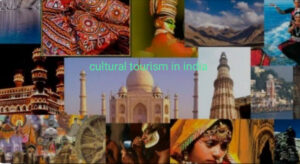
1. Cultural Tourism in India : Historical Perspective
A. Ancient Civilizations and Cultural Evolution
India’s cultural evolution traces back to ancient civilizations like the Indus Valley, where advanced urban planning flourished. Over centuries, the Vedic period laid the foundation for religious and philosophical developments. The Maurya and Gupta empires further enriched the cultural landscape, influencing art, literature, and societal norms in a fascinating journey through time.
B. Influence of Dynasties on Cultural Development
Dynasties have profoundly shaped India’s cultural development. The Mauryas, with Ashoka’s patronage, spread Buddhist ideals. The Gupta era epitomized classical arts and literature. Mughal rulers brought Persian influence, fostering art and architecture like the Taj Mahal. The Cholas championed Dravidian art and temple architecture. Each dynasty left an enduring imprint, fostering a diverse cultural tapestry that continues to thrive.
C. Architectural Marvels and Heritage Sites
India’s architectural marvels and heritage sites stand as testaments to its rich history. From the iconic Taj Mahal’s Mughal grandeur to the intricately carved temples of Khajuraho, these structures narrate tales of cultural brilliance. Ancient wonders like then and the rock-cut caves of Ellora showcase architectural prowess across dynasties, blending diverse styles. Each site, be it the historic Red Fort or the spiritual serenity of Konark Sun Temple, reflects India’s architectural diversity, inviting visitors to delve into the layers of its cultural heritage while marveling at the craftsmanship that transcends time.
2.Cultural Tourism in India : Diversity of Indian Culture
A. Linguistic Diversity and Its Impact on Cultural Tourism
India’s linguistic diversity, with over 120 languages spoken, is a cultural treasure enhancing tourism experiences. Each language represents a unique cultural identity, influencing traditions, literature, and expressions. This diversity fosters a rich tapestry of regional nuances, making cultural exploration a linguistic journey. Tourists engaging with locals in their native language often discover deeper insights, forging meaningful connections. From the Hindi heartland to the southern Dravidian languages, linguistic diversity becomes a gateway for travelers to appreciate the multifaceted cultural landscape, promoting a more immersive and authentic experience in their exploration of India.
B. Traditional Arts and Crafts
India’s traditional arts and crafts are a kaleidoscope of creativity, reflecting centuries-old skills passed through generations. Intricate handwoven textiles like Banarasi silk, vibrant Rajasthani miniatures, and the delicate craftsmanship of Madhubani paintings showcase the country’s diverse artistic heritage. Traditional crafts, from pottery to metalwork, offer a glimpse into regional aesthetics and cultural symbolism. Artisan communities, thriving in places like Varanasi and Kutch, preserve these traditions. Tourists exploring these arts not only acquire unique souvenirs but also contribute to the preservation of India’s rich artistic legacy, ensuring the continuity of these timeless expressions.
C. Festivals and Celebrations
India’s festivals and celebrations form a vibrant mosaic of cultural expressions, captivating tourists with their kaleidoscope of colors and traditions. Diwali, the festival of lights, illuminates cities; Holi splashes streets with joyous hues. Navratri’s rhythmic dance, and Eid’s communal feasts showcase religious diversity. Durga Puja in Kolkata and Ganesh Chaturthi in Mumbai transform into grand spectacles. These celebrations not only offer tourists a sensory feast but also provide profound insights into India’s religious and cultural ethos, fostering a sense of inclusivity and joy that defines the essence of the country’s festive spirit.
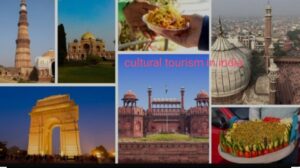
3. Cultural Tourism in India : Top Cultural Tourism Destinations in India
A. The Golden Triangle: Delhi, Agra, and Jaipur
The Golden Triangle, comprising Delhi, Agra, and Jaipur, is a cultural treasure trove that beckons tourists with its historical grandeur and architectural marvels.
1. Delhi:
Delhi, the capital, seamlessly blends ancient heritage and modernity. From the historic Red Fort and Jama Masjid to the contemporary Lotus Temple, Delhi narrates tales of diverse dynasties. The bustling markets of Chandni Chowk offer a sensory journey through time.
2. Agra:
Agra, home to the iconic Taj Mahal, epitomizes Mughal opulence. The Agra Fort and Fatehpur Sikri showcase architectural brilliance, immersing visitors in a bygone era of emperors and love stories.
3. Jaipur:
Jaipur, the Pink City, dazzles with its majestic forts, including the Amer Fort and Nahargarh Fort. The Hawa Mahal and City Palace exude Rajput splendor. Jaipur’s vibrant bazaars and the City of Palaces promise a regal cultural sojourn.
The Golden Triangle seamlessly weaves history, architecture, and cultural diversity, providing a captivating introduction to India’s rich heritage.
B. Varanasi: The Spiritual Hub
Varanasi, the spiritual hub on the banks of the sacred Ganges River, enchants visitors with its profound spirituality and timeless traditions.
1. Spiritual Significance:
Varanasi, also known as Kashi, is one of the oldest living cities in the world. Pilgrims believe that bathing in the Ganges here cleanses sins, and the city is a revered site for Hindu rituals and ceremonies.
2. Ghats of Varanasi:
The ghats, steps leading to the river, epitomize Varanasi’s spirituality. The Ganga Aarti at Dashashwamedh Ghat, a mesmerizing ritual of light and prayer, is a must-see, creating an ethereal atmosphere.
3. Temples and Alleys:
Varanasi’s narrow alleys host numerous temples, including the Kashi Vishwanath Temple, dedicated to Lord Shiva. Wandering through these labyrinthine streets reveals the city’s spiritual vibrancy.
4. Silk Weaving Tradition:
Varanasi is renowned for its silk weaving. The Banarasi sarees, intricately woven with gold and silver threads, are a symbol of the city’s artistic excellence.
Varanasi’s spiritual aura, ancient rituals, and cultural richness make it a unique destination, inviting travelers to immerse themselves in the sacred rhythms of India.
C. Rajasthan: Land of Maharajas and Forts
Rajasthan, the “Land of Maharajas and Forts,” is a captivating canvas of royal splendor and architectural marvels.
1. Majestic Forts:
The state boasts grand forts like Amber Fort in Jaipur, Mehrangarh Fort in Jodhpur, and Chittorgarh Fort. These towering structures narrate tales of valor and regal grandeur.
2. Palaces and Havelis:
Rajasthan’s opulent palaces and intricately designed havelis, such as Udaipur’s City Palace and Jaisalmer’s Paton Ki Haveli, showcase Rajput and Mughal architectural fusion, transporting visitors to an era of royalty.
3. Vibrant Culture:
Rich in folk traditions, Rajasthan hosts colorful festivals like Pushkar Camel Fair and Desert Festival, where vibrant attire, traditional music, and dance celebrate the state’s cultural vibrancy.
4. Thar Desert:
The vast Thar Desert adds a mystical charm. Camel safaris in Jaisalmer and the sand dunes of Khimsar offer a glimpse into Rajasthan’s rustic beauty.
5. Cuisine and Hospitality:
Rajasthani cuisine, with its flavorsome curries and delectable sweets, is a gastronomic delight. The warm hospitality of the locals enhances the overall cultural experience.
Rajasthan, with its regal ambiance and cultural richness, invites travelers to step into the world of Maharajas, exploring the legacy of a bygone era in every fortress and palace.
D. Kerala: Backwaters and Traditional Performing Arts
Kerala, renowned for its serene backwaters and vibrant traditional arts, offers a harmonious blend of natural beauty and cultural richness.
1. Backwaters:
The intricate network of backwaters, especially in Alleppey and Kumarakom, is a tranquil haven. Houseboat cruises along these waterways allow visitors to immerse themselves in Kerala’s idyllic landscapes.
2. Kathakali and Mohiniyattam:
Kerala’s traditional performing arts, like the dramatic Kathakali and the graceful Mohiniyattam, reflect the state’s cultural depth. These art forms, adorned with elaborate costumes and intricate makeup, narrate stories with expressive movements.
3. Classical Music and Dance:
The classical music tradition of Carnatic music finds a vibrant home in Kerala. Traditional dance forms like Koodiyattam and Theyyam add to the state’s cultural repertoire.
4. Ayurvedic Heritage:
Kerala is a hub for Ayurveda, with wellness centers offering rejuvenating treatments. Visitors can indulge in Ayurvedic therapies, experiencing the ancient healing practices deeply rooted in the state’s culture.
5. Spice Plantations:
The spice plantations of Kerala, particularly in Munnar, showcase the region’s agricultural diversity. Guided tours allow tourists to witness the cultivation of spices like cardamom, pepper, and cinnamon.
Kerala’s allure lies not only in its picturesque backwaters but also in its vibrant cultural expressions, making it a unique destination that seamlessly intertwines nature and tradition.
4. Cultural Tourism in India : Culinary Tourism in India
A. Regional Cuisine and Its Cultural Significance
Regional cuisine in India is a kaleidoscope of flavors, each dish a cultural narrative. From the fiery curries of Rajasthan to the subtle coconut-infused dishes of Kerala, culinary traditions reflect local ingredients, historical influences, and social customs. Exploring these diverse tastes becomes a journey through India’s rich cultural tapestry.
B. Street Food Culture
India’s street food culture is a vibrant culinary adventure, where bustling markets and roadside stalls offer a sensory feast. From Mumbai’s iconic vada pav to Delhi’s spicy chaat, each city boasts its unique flavors. Street vendors craft diverse delicacies, showcasing regional specialties and cultural diversity, creating an immersive and delectable experience for adventurous food enthusiasts.
C. Culinary Workshops and Experiences for Tourists
Culinary workshops and experiences in India provide tourists with hands-on immersion into the rich tapestry of Indian flavors. From spice markets in Delhi to cooking classes in Udaipur, visitors can learn traditional recipes, mastering the art of biryanis, curries, and sweets. These experiences not only tantalize taste buds but also foster a deeper appreciation for the cultural significance intertwined with every dish.
5. Cultural Tourism in India : Living Cultural Traditions
A. Traditional Dance Forms and Music
India’s traditional dance forms and music are captivating expressions of its cultural diversity.
1. Bharatanatyam and Kathak:
Bharatanatyam, with its precise footwork and expressive storytelling, originates from Tamil Nadu, while Kathak, with its intricate spins and footwork, is a North Indian classical dance form.
2. Odissi and Manipuri:
Odissi, from Odisha, is characterized by fluid movements, and Manipuri, from Manipur, combines graceful postures with rhythmic patterns.
3. Classical Music:
Hindustani and Carnatic classical music traditions offer a melodic journey. Instruments like the sitar, tabla, and veena enrich the musical landscape.
4. Folk Dances:
India’s diverse regions boast a myriad of folk dances, from Bihu in Assam to Garba in Gujarat, each reflecting local customs and celebrations.
5. Ghazals and Bollywood Music:
Ghazals showcase poetic depth, while Bollywood music adds a contemporary flair, creating a dynamic spectrum of musical expressions.
These traditional dance forms and music genres weave a vibrant tapestry, showcasing the cultural intricacies and artistic richness of India.
B. Handicrafts and Artisan Communities
India’s handicrafts and artisan communities form the backbone of a rich cultural legacy.
1. Varied Crafts:
Skilled artisans create a myriad of crafts, from intricate handwoven textiles like Banarasi silk to exquisite pottery, woodwork, and metalcraft, each representing regional expertise.
2. Artisan Clusters:
Vibrant artisan clusters, such as the Kutch region for embroidery and Jaipur for block printing, serve as cultural hubs where traditions are meticulously passed down through generations.
3. Sustainable Practices:
Many artisans embrace sustainable practices, using eco-friendly materials and traditional techniques, contributing to the preservation of cultural heritage and the environment.
4. Cultural Significance:
Handicrafts often carry cultural symbolism, with designs inspired by mythology, nature, and local customs, making each piece a story in itself.
By supporting these artisan communities, tourists not only acquire unique handmade souvenirs but also contribute to the preservation of India’s diverse and intricate cultural heritage.
C. Cultural Events and Fairs
India’s cultural events and fairs are kaleidoscopic celebrations, offering a vivid glimpse into the nation’s diverse traditions.
1. Pushkar Camel Fair:
This Rajasthan extravaganza blends cultural events with a vibrant market, featuring camel races, folk performances, and the iconic trading of livestock.
2. Kumbh Mela:
The world’s largest religious gathering, the Kumbh Mela, is a spiritual spectacle where millions gather for ritualistic bathing and cultural festivities.
3. Surajkund Crafts Mela:
This Haryana fair showcases India’s handicraft diversity, attracting artisans from across the country to exhibit and sell their traditional wares.
4. Durga Puja in Kolkata:
Kolkata’s grand celebration of Durga Puja transforms into an artistic and cultural extravaganza, featuring elaborate pandals, traditional dances, and cultural events.
5. International Film Festival of India (IFFI):
Goa hosts IFFI, a cinematic celebration that brings together filmmakers, actors, and enthusiasts from around the world, fostering cultural exchange through the lens of cinema.
Attending these events allows tourists to immerse themselves in India’s dynamic cultural landscape, where traditions, art, and festivities converge in a vibrant tapestry.
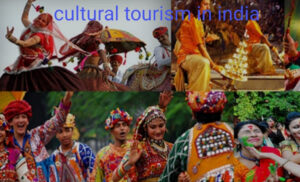
6. Cultural Tourism in India : Challenges and Conservation Efforts
A. Threats to Cultural Heritage
India’s cultural heritage faces several threats that endanger its historical richness.
1. Urbanization and Development:
Rapid urbanization and modern development often lead to the neglect or destruction of historical sites and traditional structures, eroding the tangible aspects of cultural heritage.
2. Environmental Factors:
Natural disasters, pollution, and climate change pose threats to monuments, artifacts, and traditional practices, impacting the sustainability of cultural elements.
3. Tourism Impact:
Unregulated tourism can contribute to wear and tear on historical sites, sometimes leading to vandalism, theft, or inappropriate commercialization, endangering the authenticity of cultural experiences.
4. Political Unrest and Conflict:
Areas affected by political unrest or conflict may witness deliberate destruction of cultural symbols as a means of erasing historical identities.
5. Globalization and Cultural Homogenization:
The influence of globalization may lead to the dilution of unique cultural practices, languages, and traditions, as external influences reshape local identities.
Preserving India’s cultural heritage necessitates a delicate balance between development and conservation, fostering awareness and responsible tourism practices to ensure the longevity of this rich tapestry for future generations.
7. Digital Influence on Cultural Tourism
A. Social Media and Its Impact on Cultural Tourism
Social media has revolutionized cultural tourism in India, influencing how travelers discover, experience, and share their cultural journeys.
1. Digital Discovery:
Platforms like Instagram, Facebook, and YouTube allow travelers to explore cultural destinations virtually, enticing them to discover the diverse offerings of India.
2. Real-Time Recommendations:
Social media serves as a real-time source of recommendations, where tourists share insights, tips, and reviews, shaping the cultural narrative of destinations.
3. Community Engagement:
Cultural events, festivals, and local experiences gain visibility through social media communities, fostering a global audience and encouraging cultural exchange.
4. Influencer Impact:
Travel influencers and bloggers play a pivotal role, sharing immersive content that inspires and guides followers, shaping perceptions and preferences related to cultural tourism.
5. Preservation Advocacy:
Social media platforms empower advocates for cultural preservation, raising awareness about the importance of protecting heritage sites and promoting responsible tourism.
While social media enhances cultural tourism accessibility, it also demands responsible usage to ensure the authentic representation and sustainable appreciation of India’s diverse cultural heritage.
8. Tips for Cultural Tourists in India
A. Engaging with Local Communities
Engaging with local communities is a key aspect of responsible cultural tourism in India.
1. Homestays and Community Tourism:
Opting for homestays provides tourists with the opportunity to immerse themselves in local lifestyles, fostering direct interaction with residents and promoting cultural exchange.
2. Participating in Local Festivals:
Attending festivals allows tourists to share in the joy of cultural celebrations, offering a firsthand experience of traditional rituals, music, and dance.
3. Support Local Markets:
Shopping at local markets supports small businesses and artisans, providing economic benefits to the community while allowing tourists to acquire authentic handmade souvenirs.
4. Cultural Workshops and Classes:
Engaging in workshops, such as cooking classes or traditional art sessions, enables tourists to learn directly from locals, fostering a deeper understanding of cultural practices.
5. Responsible Photography:
Respecting local privacy and seeking permission before taking photographs ensures a respectful interaction, preventing the intrusion into the daily lives of community members.
By actively engaging with local communities, tourists contribute to the preservation of cultural authenticity and create meaningful connections, enhancing their overall cultural experience in India.
Conclusion:
Cultural tourism serves as a powerful catalyst for global understanding, transcending borders and fostering connections. By immersing travelers in diverse traditions, languages, and lifestyles, it cultivates empathy and appreciation for the richness of human experiences. Through firsthand encounters with different cultures, tourists become ambassadors of understanding, breaking down stereotypes and promoting a more interconnected world. Cultural tourism becomes a bridge, uniting people in shared appreciation and respect for the varied tapestry of global heritage.
FAQs:
1.What is an example of cultural tourism?
2.What are the 5 types of cultural tourists?
3.Which state in India has rich culture?
4.What are the examples of ethnic tourism in India?
5.Cultural places in India
6.Heritage tourism in India Project
7.Cultural tourism examples
8.Cultural tourism in Rajasthan
